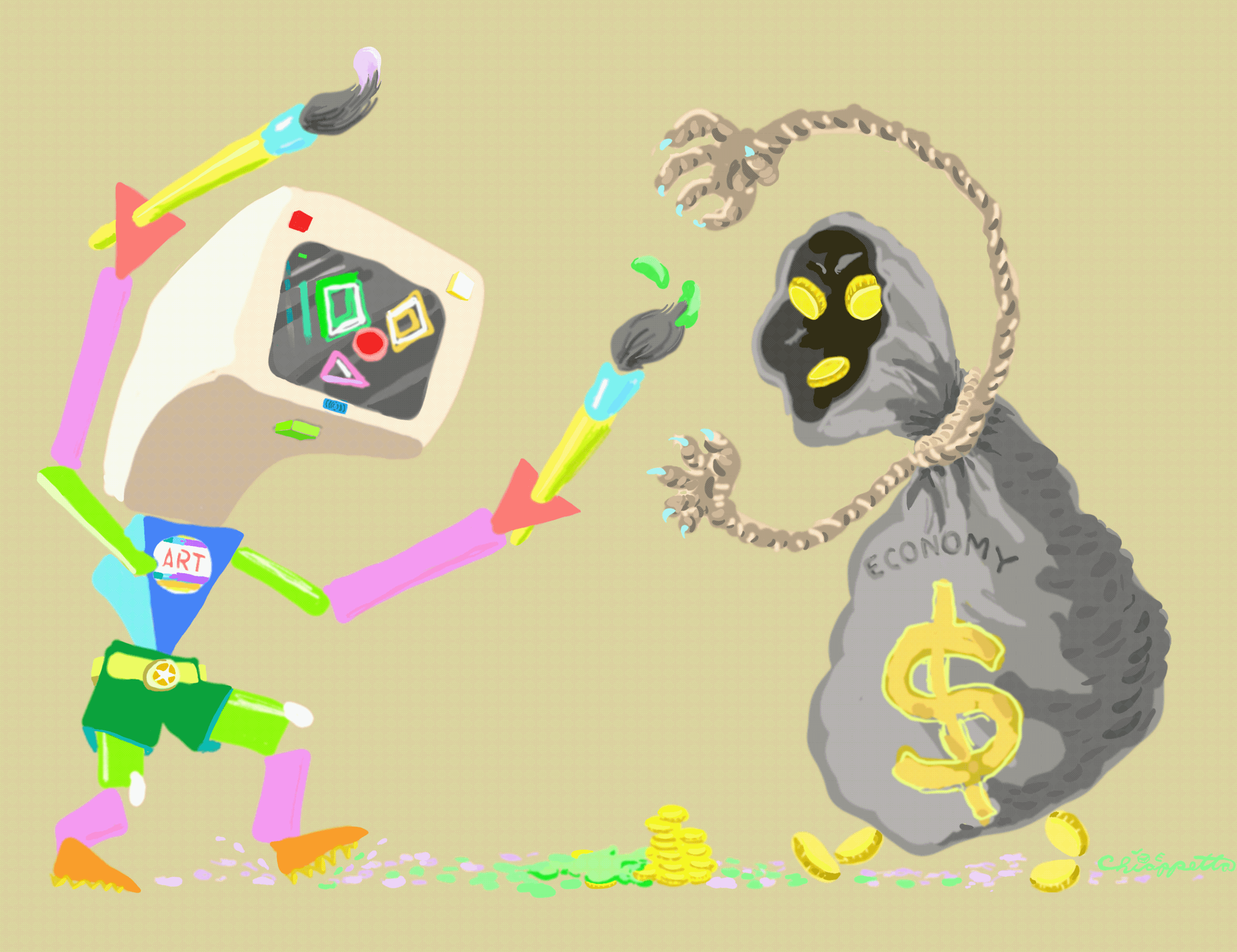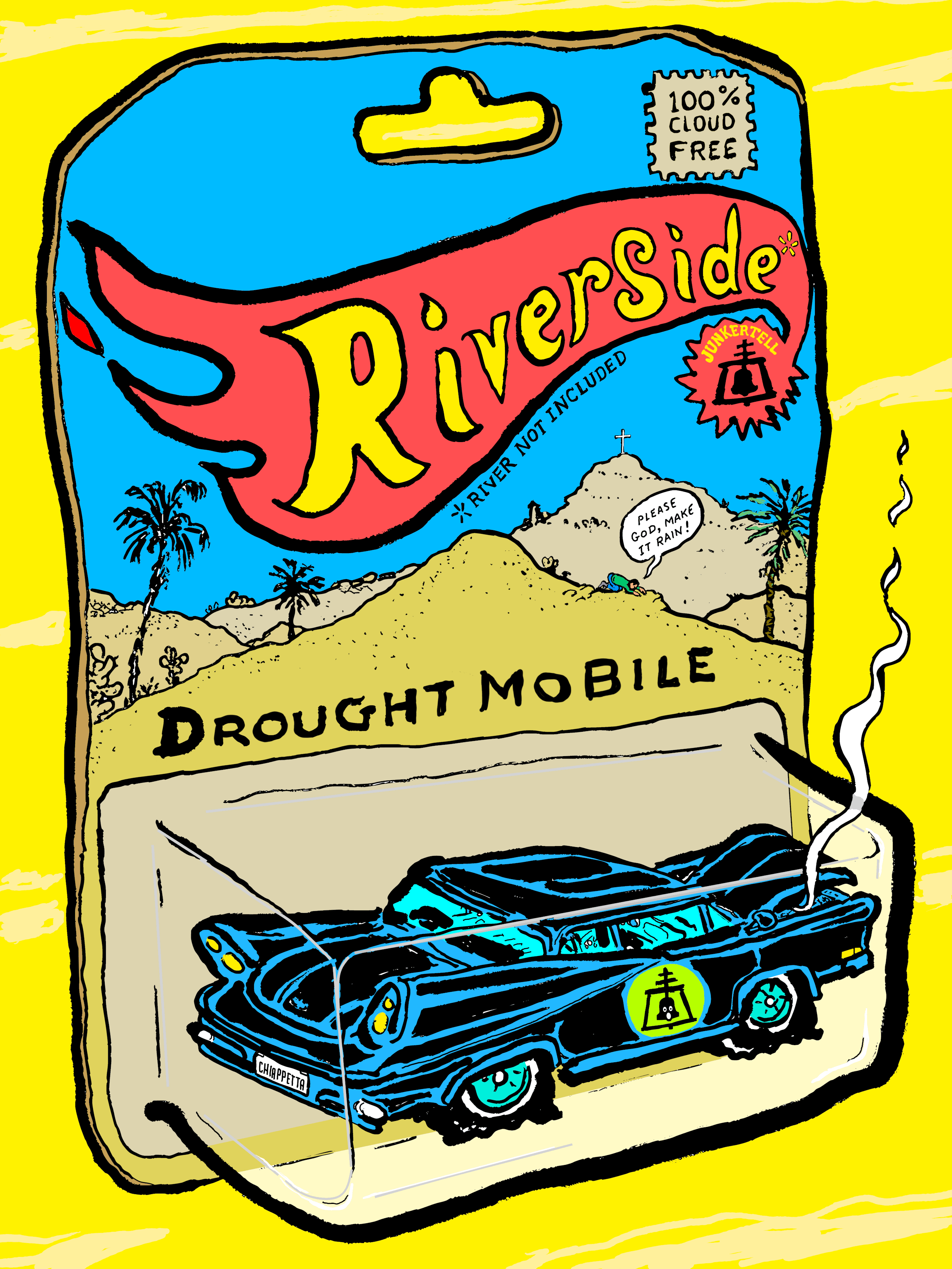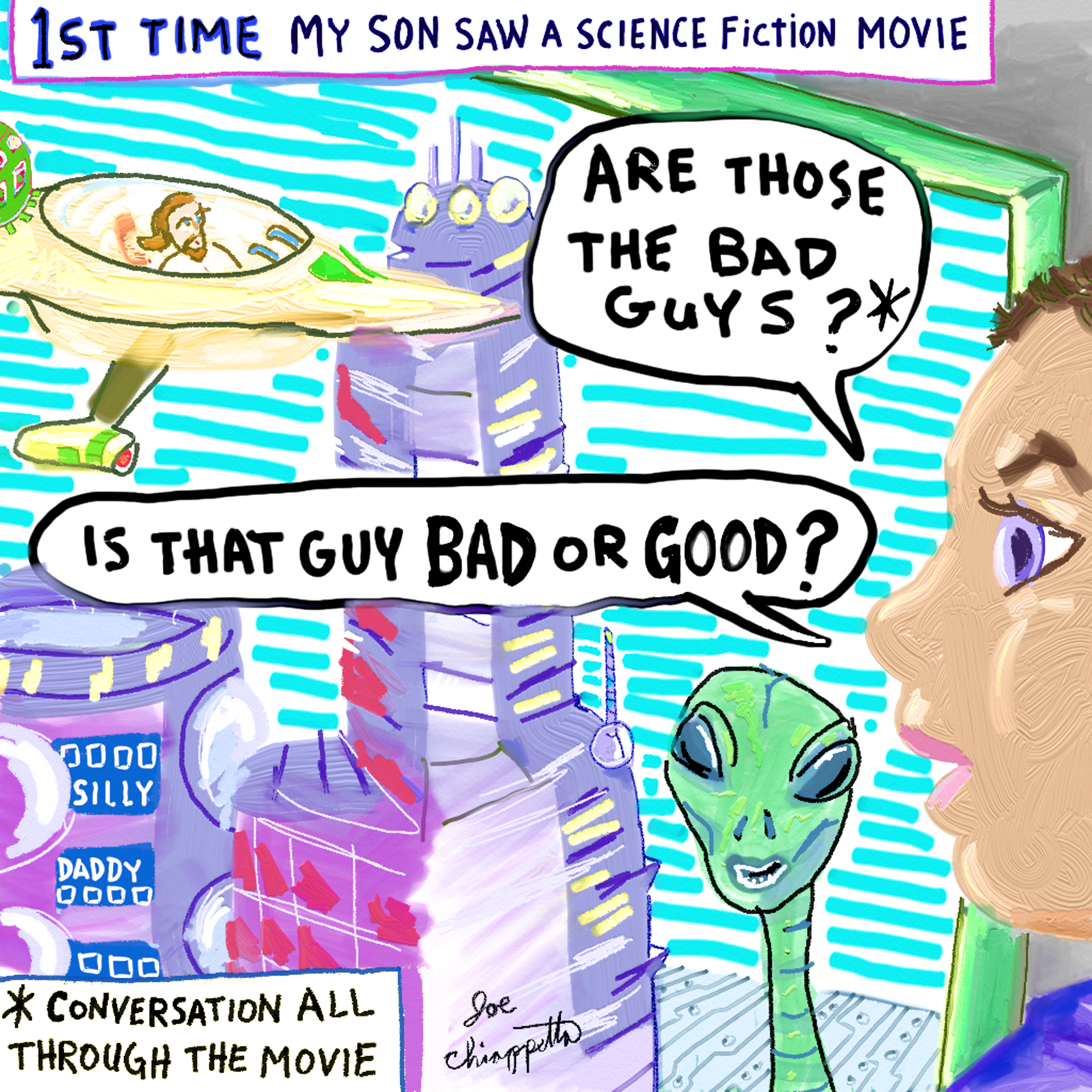Joe Chiappetta on Silly Daddy Comics, NFTs, and Over 25 Years of Digital Art
By Cansu Waldron
An award-winning cartoonist and digital art pioneer, Joe Chiappetta has been creating art since long before “digital” was a common word in the studio. Originally from Chicago and now based in California, he is best known for Silly Daddy Comics and ArtVndngMchn, with a career spanning the Independent Comics Publishing Movement of the 1980s to today’s Rare Digital Art and Cryptoart scenes. His work blends humor, family, and faith, often reflecting a lighthearted yet deeply personal perspective.
Starting in 1994, Joe began experimenting with early digital tools like CorelDraw while working in a screen printing shop, quickly realizing the revolutionary potential of editing, layering, and coloring on a computer. Over the years, he explored portable digital creation on Pocket PCs, producing hundreds of illustrations that would later appear in comics, NFT projects, and a 2025 science fiction novel, Star Chosen. Across decades, his practice has remained rooted in curiosity, playfulness, and a commitment to using new technologies to expand storytelling and artistic expression.
We asked Joe about his art, creative process, and inspirations.
You’ve been creating digital art since 1994 — before most people even knew what that meant. What first drew you to experiment with digital tools back then?
At the time I worked in the art department of a screen printing shop in Chicago. The owner wanted to modernize, so he bought a computer and CorelDraw for the department. They even paid for me to receive a week of in-person training with a CorelDraw expert. As an active cartoonist doing zines at the time for nearly 10 years, I was blown away by the ease at which I could make revisions and edits to art and text. And all the colors were so rich and vibrant--even the grays and browns.
I get that now, in a super-saturated computer and AI age, we take that stuff for granted. Yet for a 1980s-trained cartoonist to be able to endlessly move around art elements as well as text fonts and sizes in a matter of seconds, this was pretty revolutionary. I come from the age of comics and zine making where most things were hand-lettered and many images--drawn with pencils and later inked--were photocopied down to size and glued in place.
So between making t-shirt designs for football, baseball, and wrestling teams, I would also "draw" using a mouse and experiment like crazy with these vectorized tools. Issue number 4 of my comic zine called "Silly Daddy" was produced entirely digitally before being printed. It remains one of the most bizarre, experimental, and rare zines I have ever made.
A few years later, Pocket PCs came out. These were not phones, but they ran a super light, modified version of Microsoft Windows called Windows Mobile. The big deal, at least for me, was that they actually fit your pocket--and most importantly--they were operated by a very accurate and fast responding stylus! For an artist in the early 2000s to have a pocket-sized digital color sketchbook was a game changer. From about 2000 to 2005, my go-to device for much of my art-making were HPs iPaq line of Pocket PCs. Bringing such devices literally everywhere I went, I made hundreds of drawings, paintings and comics on those devices. Many of these works ended up in subsequent Silly Daddy comics in print. Some of these digital creations also got reworked into NFTs that I would go on to release over a decade later.
In fact, so many drawings were produced from that era that I am still harvesting them today for a science fiction novel I just released in 2025. It is called "Star Chosen." Many of the original character designs from this novel were first sketched out on a Pocket PC in 2005 as I rode the train to my day job in downtown Chicago. Some of these drawings end up in the final version of the book, as it has over 100 illustrations in it.
Looking back to your early days in the Independent Comics Publishing Movement, what did “independence” mean to you as an artist?
The independence of being able to publish your own stuff and release it directly to stores was still in its infancy back then. This was long before the internet. Customer-facing print-on-demand was still 25 years away. So to get into comic book stores and book stores, publishers needed to fund large print runs, store them somewhere, and also find a distributor while they literally marketed store-to-store. But by the 1980s and 90s, a growing number of publishers did exactly that. I was one of them and it was liberating.
We bypassed mainstream publishing gatekeepers, promoted each other's work, and a whole new community was formed. Readers tired of the same old corporate recycled plot found fresh and exciting content from this rising wave of independent publishers. We gathered at conventions and solidified our commitment to each other through old-fashioned snail mail. It was a super-enriching experience.
So ultimately, "independence," as a die-hard artist is saying that I am not going to cater to what the mainstream, corporate-led market wants. I am going to make what I believe needs to be made, and release it to the public. Then, God-willing, I will find the people that appreciate my vision. Yet even if I don't, I will not compromise in what I believe needs to be created and said. If that means I lose readers and buyers, so be it. If that means I have to work a side job, then amen. On my Pocket PC, in my hour-long commute from the office, I will digitize until art is actualized.
Can you tell us about Silly Daddy Comics? How much of your own family life finds its way into those stories?
Silly Daddy comics are typically pretty autobiographical and started as photocopied zines, also known back then as mini-comics. Starting in 1991, I was one of the earliest auto-bio cartoonists to consistently write about family from a father's perspective. Later I also got into allegorical stories and shorter-form social commentary--which can be seen today in much of my rare digital art. But even today, in one way or another, I call upon my Silly Daddy roots: sometimes silly, often fatherly, and determined to foster family wherever I am in a do-it-yourself, home-grown manner.
If I could advise whoever does my retrospective book collection comprehensive art exhibit upon my death, I have some things to say. I hope those curators will discover the medium-bouncing continuity of Silly Daddy. Despite the fact that I don't do a printed quarterly comic book of that title any more, my true desire is that future curators will see Silly Daddy as a cohesive, yet loose continuum of print, paint, and digital work that communicates my fascinating journey. This extends into my cryptoart work from 2015 and my NFT work starting in 2018. In fact, even in my sci-fi novel, Star Chosen, there is so much of a "Silly Daddy" presence in a number of the dads in that space opera. I think the casual observer, unaware of my early print comic work, may miss this point. Yet I refuse to be bound to one style, nor will I be bound to one medium.
You were involved early in the Cryptoart and Rare Digital Art movements. What was that moment like — did it feel revolutionary, or more like a natural extension of what you were already doing?
I started making art about crypto, which is what I call "cryptoart," in 2015... maybe even earlier. And at first it was frankly a little lonely. For a while I actually thought I was the only cartoonist doing comics about crypto. But by 2017 and 2018, when NFTs became more accessible, we all started to find each other and it was pretty heartwarming--and often even thrilling. It was like, "Wow, other artists appreciate this tech too? Awesome! Let's be friends... friends for life! Oh, and we can also have distribution for our digital art? Fantastic? Wait, we might make money at this too--in crypto? Even better. I'm all in! Oh, this has never been done before? Super. Of course we're revolutionaries. That's what we signed up for!"
Literally that's precisely how the early days were: full of revolutionary breakthroughs and discoveries! That early cryptoart and NFT scene has so much in common with the early days of the 1980s zine scene. In both cases there was young technology that became much more accessible (photocopy machines/blockchains) as well as artistic communities built around these modes of expression and distribution (comic book and record shops/NFT marketplaces). The results, in both cases produced memorable, rewarding relationships, comradery, history-making creations, and an income.
What inspired ArtVndngMchn, and how do you see it evolving?
By nature, I am a gatherer and, as stated previously, a dad figure. So I wanted to create a group to gather artists whose work I appreciate and help them. It's about accomplishing professional goals together and creating community over common ground. Since the business side of the arts can be a lonely yet competitive place, from time to time we band together for commerce in a metaphorical art vending machine, which I brand as ArtVndngMchn. Over 100 artists have been involved in ArtVndngMchn's various activities over the years. We have released NFTs together in randomized packs, raising $9000 to support a school for poor children in Africa. I was actually the first curator to do that with fine artists on the blockchain. For a few years we built and hosted interactive exhibits in the metaverse via ArtVndngMchn Amusement Park. We have also released a paperback zine called "ArtVndngMchn Mission Wonderful." Most recently, my wife, Denise, and I hosted ArtVndngMchn Garage, where artists drew cars and released them as NFTs for a chance to win crypto. This we did on the zeroone platform. Between this year's contest and last year's, we have awarded digital artists over $2200.
Having witnessed so many shifts in how digital art is shared and valued, what changes have excited you the most — and which have challenged you?
What has excited me the most about digital art is the NFT functionality of it. At heart, in some core part of my being, I am still a 1970s kid trading Marvel superhero stickers with my friends at lunchtime on the playground. So NFTs give some of that same use-case for digital art. That's still pretty thrilling.
I am also grateful for being able to draw on an e-ink tablet. I use Remarkable (version 1) and it is so easy on the eye with no back light. The pen and screen are very responsive to pressure sensitivity so I appreciate being able to get rich brush size variations all in one stroke. I have probably drawn over 100 NFTs this way.
As for challenges, where shall we begin? Adobe Illustrator going from a CD program to a subscription model? The promise of the metaverse being widely adopted? NFT marketplaces that went out of business? Scammers flooding this space with hype-cycle copycat junk NFTs? The ever-increasing blockchain silos that limit the reach of great NFT art? Yes, all these (and more) have been a burden). Nevertheless, the world is only tracking to get MORE digital. So digital art, naturally, is here to stay.
What is a fun fact about you?
I collect die-cast cars. My studio office is full of them. Naturally, versions of these fun vehicles end up in my digital art too.
What else fills your time when you’re not creating art?
I am very active as a congregational pastor. Before becoming a Christian over a quarter of a century ago, I used to simply think that a gift I got from God was the ability to draw. Now I understand there was much more to it. That gift actually came with the ability to communicate in a way that helps people nurture their own healthy vision. I fight to keep that responsibility very much alive.
What is a dream project you’d like to make one day?
I would love to make both Silly Daddy (set in the present day), as well as Star Chosen (set far into the future), into live-action movies.























